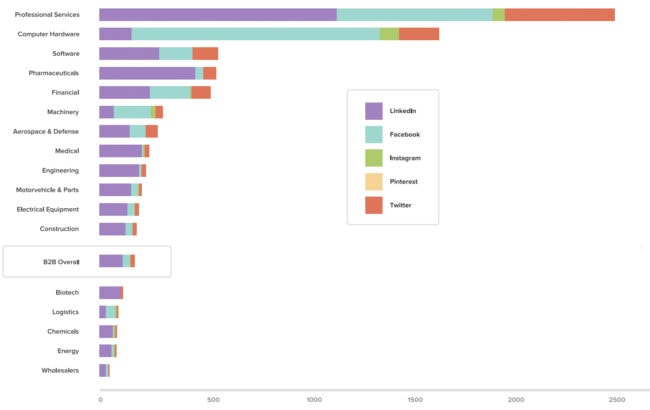How to take your CEO on the journey to build best-in-class marketing
It’s time to shake the unconscious bias surrounding B2B social media marketing.
Despite winning significant traction in recent years, social media is sometimes still treated like the kid at the grown-up table when it comes to business to business enterprise. Yet, best of breed B2B marketing sits social media front and centre.
Take this Track Maven report on B2B social media. Below is an industry break down of audience size (in the 1000’s) of U.S B2B companies utilising Facebook, Twitter, LinkedIn, Pinterest and Instagram.
It’s not small. And it’s not confined to business networks.

In the Green Hat/AMI B2B Marketing Research Report, best-in-class marketers were twice as likely to be satisfied with their social media marketing as other respondents. But that’s among those businesses already investing in it. Some still need convincing.
Here are six myths we need to shrug off for good:
1. Social media doesn’t work for B2B
It’s true that social media won’t always be the most critical cab off the rank when venturing into B2B digital marketing for the first time, but it’s foolish to consider it an optional extra or unimportant fluff.
Social media can deliver the same or more value for B2B as B2C – across brand and product awareness, lead acquisition, reputation building, customer service and market intelligence.
You need to find and engage customers where they are, and the data doesn’t lie. They’re using social media.
2. Social is a separate plan
Digital marketing is an ecosystem that works most effectively when it’s integrated. Social tactics, content and metrics must connect to drive outcomes. Choose the right channel for the right audience at the right time.
You need a 360-degree view of your customer, and their social footprint is a key piece of the puzzle.
3. LinkedIn is the only worthwhile channel
As the world’s go-to professional social network (for now at least), LinkedIn will remain a channel of choice for B2B marketers for some time yet. But it’s both naive and flat out wrong to assume B2B audiences are exclusively engaging in that social network.
Business leaders and B2B decision-makers spend long, engaged hours on Facebook, Twitter, YouTube and other social channels in their daily lives. While we might not officially be ‘working’, most of us don’t disengage parts of ourselves when we’re consuming content and interacting in these more personal contexts.
A new report from Hotwire and Vanson Bourne called The Changing Face of Influence, polled 1000 senior decision-makers in business and found that one in four (24 per cent) named Facebook as their preferred social channel when seeking information on a purchasing decision, ahead of LinkedIn. Track Maven’s report logged 20 times more engagement on Instagram than on LinkedIn for B2B.
3. Social is only for lead generation
In the early days of social media, marketers were reluctant to leverage social for selling, correctly recognising that different rules applied in these new spaces.
The now famous analogy was invoked – blundering into someone else’s conversation at a dinner party and handing out your business card uninvited. But social network platforms are now the world’s biggest advertising businesses, and people are accustomed to mixing business with pleasure. We live, work, play and shop social. It’s ok to introduce yourself – providing it’s done respectfully and constructively.
Social media can be used to significantly increase awareness and consideration, improve lead qualification, to personalise campaigns or product offerings, for competitor analysis, reputation management, customer service and more.
4. Social has to be automated
B2B has the opposite challenge to much of the B2C social media world.
Whereas B2C social media marketers are wrestling with ways to include smart automation in their efforts without losing the human touch, B2B marketers accustomed to the benefits of automation in other cases are more inclined to use it immediately for social media, without considering where a personalised touch can support their efforts.
Just as with B2C, the right approach is a hybrid of human and machine, leveraging automation to monitor and scale, and humans to craft priority content and have priority conversations.
5. Social media isn’t measurable
Like most things digital, social media is immensely measurable. In fact, it’s one of the most measurable marketing methods of all, at a granular level. Innumerable tools and best practice templates can surface meaningful numbers and benchmarks to guide your practice.
The key is to align your B2B objectives with your social metrics. Don’t get blindsided by counting Likes; consider how social media can move the needle on your overall marketing objectives, such as reach and awareness, product validation, propensity to purchase and of course, quality lead generation.
Read more: B2B marketing needs to start tugging on heart-strings
6. Fancy tricks are for B2C
Video, .gifs, memes, cinemagraphs – these aren’t superficial tricks reserved for consumer brands. While it’s fair to say B2B audiences are more interested in cutting to the information of value, storytelling and persuasion devices like the above still work.
If you can compellingly summarise the contents of a white paper in a 30-second video, what time-poor executive wouldn’t love that? Create an audio white paper for decision-makers on the go, or make your case studies irresistibly ‘thumb-able’ in a Facebook feed.
The web is fundamentally visual now, and social network platforms are primed to hero visual content that cuts through. So it makes sense to adjust your playbook and modify the ‘old rules’.
Future-proof your marketing efforts
Millennials aren’t just re-orientating companies to be more purpose led and culturally rich, they are looking to different channels, contexts and content to offer them value as professionals.
The next generation of B2B decision-makers will expect their social networks and online communities to introduce them to opportunities, products and solutions for their business. And they’ll expect them to do so in the ways most resonant to the platforms they live on.
Marketers who don’t creatively approach engagement across these channels as part of a holistic B2B marketing strategy risk appearing out-of-touch and missing the mark.
The findings in this article refer to the 2017 B2B Report. For the latest B2B research, download your complimentary copy of our latest B2B Marketing Research Report.

 Social Media
Social Media





